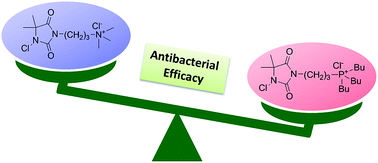Synthesis of quaternary phosphonium N-chloramine biocides for antimicrobial applications†
Abstract
The recently developed quaternary ammonium (QA) N-chloramine has been proved to be a promising “composite” biocide with drastically boosted antibacterial efficacy afforded by the QA moiety. In this work, a series of quaternary phosphonium (QP) N-chloramine biocides, covalently combining an N-chloramine moiety and a QP moiety via varied aliphatic methylene units, were synthesized by means of multi-step chemical reactions. Preliminary antibacterial tests against both Escherichia coli (E. coli) and Staphylococcus aureus (S. aureus) showed that the synthetic QP N-chloramine exhibited distinctively higher biocidal efficacy than the QA counterpart. Furthermore, bactericidal tests also indicated that QP N-chloramine with a linker of –(CH2)12– showed the highest biocidal efficacy, suggesting synergistic action between the N-chloramine moiety and QP moiety.



 Please wait while we load your content...
Please wait while we load your content...